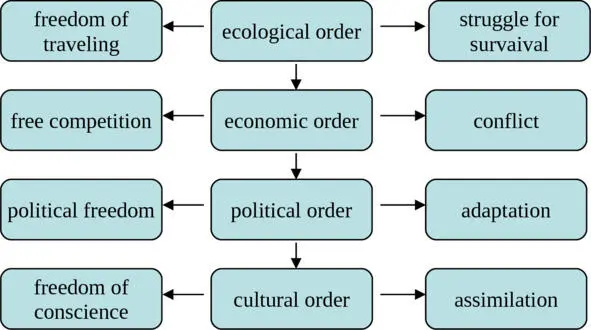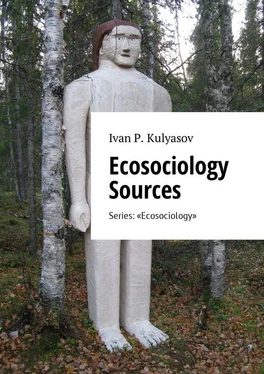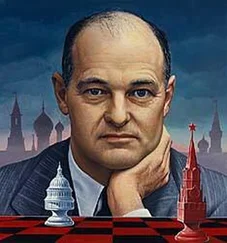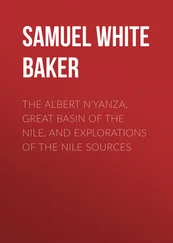I. Kulyasov - Ecosociology Sources. Series - «Ecosociology»
Здесь есть возможность читать онлайн «I. Kulyasov - Ecosociology Sources. Series - «Ecosociology»» — ознакомительный отрывок электронной книги совершенно бесплатно, а после прочтения отрывка купить полную версию. В некоторых случаях можно слушать аудио, скачать через торрент в формате fb2 и присутствует краткое содержание. ISBN: , Жанр: Прочая научная литература, на английском языке. Описание произведения, (предисловие) а так же отзывы посетителей доступны на портале библиотеки ЛибКат.
- Название:Ecosociology Sources. Series: «Ecosociology»
- Автор:
- Жанр:
- Год:неизвестен
- ISBN:9785449009913
- Рейтинг книги:5 / 5. Голосов: 1
-
Избранное:Добавить в избранное
- Отзывы:
-
Ваша оценка:
- 100
- 1
- 2
- 3
- 4
- 5
Ecosociology Sources. Series: «Ecosociology»: краткое содержание, описание и аннотация
Предлагаем к чтению аннотацию, описание, краткое содержание или предисловие (зависит от того, что написал сам автор книги «Ecosociology Sources. Series: «Ecosociology»»). Если вы не нашли необходимую информацию о книге — напишите в комментариях, мы постараемся отыскать её.
Ecosociology Sources. Series: «Ecosociology» — читать онлайн ознакомительный отрывок
Ниже представлен текст книги, разбитый по страницам. Система сохранения места последней прочитанной страницы, позволяет с удобством читать онлайн бесплатно книгу «Ecosociology Sources. Series: «Ecosociology»», без необходимости каждый раз заново искать на чём Вы остановились. Поставьте закладку, и сможете в любой момент перейти на страницу, на которой закончили чтение.
Интервал:
Закладка:
Environmental sociology, as an area of sociological research and theorizing, took its final shape in the 1920s – 1930s and is associated with such names as Robert Ezra Park (1864—1944), Ernest Watson Burgess (1886—1966) and Roderick Duncan McKenzie (1885—1940). They studied specific urban issues using quantitative sociological methods including systematizing and formalization of data gathered, territorial zoning and group segregation. This allowed studying the processes of deviant behavior, migration and adaptation 14 14 McKenzie R.D., Park R.E., Burgess E.W. The city. Chicago: Chicago University Press. 1967.
.
At that time, Chicago as a social environment was a fascinating object of research. It demonstrated a complete set of situations and cases, which individually could be found in the other United States cities. Special attention was paid to labor strikes and demonstrations that often turned into mass civil unrest, migration processes and adaptation of ethnic communities, growth and organization of crime. As sociologists were eager to offer new ideas, they were expected to find ways for resolving these problems.
The socio-ecological concept proposed by the Chicago school of sociology was applied to a specific object / subject, relied upon an evolutionary approach to studying social change and the naturalistic approach to selecting methods of research. The Chicago school sociologists rejected Spencer’s theory of universal progress conceding to this notion only after generalization of specific research materials and admitting the possibility of progress in sociological cognition 15 15 Park R.E. Human nature and collective behavior // American Journal Sociology. 1927. Vol. 32. №5. p. 695—703.; Human ecology // American Journal Sociology. 1936. Vol. 42. №1. p. 1—15.
.
They emphasized a natural origin of conflict and the consistency of its transformation into an optimal state of consensus. This concept viewed conflict and consensus as interrelated and mutually complementary aspects of a single process of evolution. This description of the process of social change, the use for analysis of a tool for elaboration of dual, dichotomous and paired interrelated opposites determined the subsequent fate of the socio-ecological theory that combined a diversity of approaches.
The socio-ecological concept was based on the idea that society (urban community) is a complex system, organism and a biological phenomenon. Accordingly, in addition to the socio-cultural level, it has a biotic quality, which underpins all social development and determines social organization of the urban community. Therefore, in Park’s opinion, society forms at the biotic level while the cultural level emerges in the process of social evolution.

Schema: Social evolution
The starting point for analysis became the most developed social phenomena. Social evolution moves from the biotic to the cultural level and is driven by competition, which takes various forms in the course of evolution and achieves an optimum – competitive cooperation – at the cultural level. Competition forms the structure and regulates the sequence of change and restoration of equilibrium in the development of the social organism.
Social change per se looks as a process consisting of several consecutive phases, each of them being the result of the preceding forms of competition. After that, Park systematized and structured analytical conclusions. These methods allowed obtaining new knowledge and seeing phases of evolution and links between the biotic and cultural levels.
Park identified four phases of the evolution process from the biotic to social level: the ecological, economic, political and cultural orders. Accordingly, there exist four forms of socialization, namely, competition – struggle for survival on the biotic level, conflict on the economic level, adaptation on the political level and assimilation – on the cultural level.
All four are represented in the modern society in different situations (specific cases) to a varying extent (quantitative parameters) but with the same characteristic features:
– Ecological order is the result of physical (space-temporal) interaction of individuals. This order is characterized by freedom of traveling.
– Economic order exists where there is production, trade and exchange and is characterized by free competition.
– Political order prevails where there is control, management, regulation and enforcement. It is characterized by political freedoms.
– Cultural order is characterized by the dominance of morals, ethics, traditions, habits and customs, which form social institutes and structures, and which in turn, specify restrictions for individuals and society. However, this restriction is taken for granted as it is based on consensus 16 16 Park R.E. Society: Collective behavior, news and opinion, sociology and modern society. Glencoe: Free. 1955.
.
Communication (interaction) capacity is inborn and makes a newly born baby a human. He is striving to communicate and this striving compels him to agree to curb his instincts, desires and aspirations. After that, social institutes and structures are reproduced as a result of collective action and consensus on a daily basis. Interactionism boils down to the postulate that individuals use communication to socialize and integrate. His process allows consecutive and coordinated action leading to a consensus-based or authoritative interaction, suppression of the minority by the majority, or majority of citizens by the elite representing a minority.
However, the anticipated interaction may not necessarily occur. Then interaction occurs in another situation in another form. This means that interaction is determined by the human nature. Interaction is based on movement, which characterizes the ecological level. This particular level is the subject examined by ecosociology, while the hierarchically structured superstructure – economic, political and cultural orders – are studied by economy, political science and anthropology.
Despite the attractiveness of studying the cultural level, the Chicago school ecosociologists, together with students, researched the urban environment fully using the structure suggested by Park. Naturally, they paid a lot of attention to the ecological level, which could be used for studying migration processes. Researchers acted on the assumption that a social organism consists of individuals capable of migration. Migration is a collective action and interaction typical specifically for the biotic (ecological) level. It is a basic freedom for all people irrespectively of the race and nationality.
Availability of higher-level freedoms (of conscience, political and economic freedom) is the subject matter of a new scientific discipline – cultural-anthropological ecology. The central concept of this science is “liberty” as a feature of modern society. The degree of freedom may increase or decrease on a case-by-case basis. For a human, the greatest external freedom is possible at the ecological level (in contrast with plants, humans have a freedom of movement), and inner freedom – at the cultural level (unlike animals, humans consciously choose their behavior).
On the one hand, all American reforms are supposed to be aimed at securing freedom for individuals and society and building a free American society. On the other hand, nobody ever plans or builds a free society; it emerges of its own accord where it does not oppress itself. And it emerges due to the biotic nature of humans – their ecological level. Therefore, the 19 th-century wave of migration to the United States from China, Asia, India and Middle East indicates the switching of an in-depth mechanism that would change the existing institutes to build a qualitatively new society of free cooperation.
Читать дальшеИнтервал:
Закладка:
Похожие книги на «Ecosociology Sources. Series: «Ecosociology»»
Представляем Вашему вниманию похожие книги на «Ecosociology Sources. Series: «Ecosociology»» списком для выбора. Мы отобрали схожую по названию и смыслу литературу в надежде предоставить читателям больше вариантов отыскать новые, интересные, ещё непрочитанные произведения.
Обсуждение, отзывы о книге «Ecosociology Sources. Series: «Ecosociology»» и просто собственные мнения читателей. Оставьте ваши комментарии, напишите, что Вы думаете о произведении, его смысле или главных героях. Укажите что конкретно понравилось, а что нет, и почему Вы так считаете.




![Джеймс Купер - Пионеры, или У истоков Саскуиханны [The Pioneers, or The sources of the Susquehannah]](/books/395797/dzhejms-kuper-pionery-ili-u-istokov-saskuihanny-t-thumb.webp)







